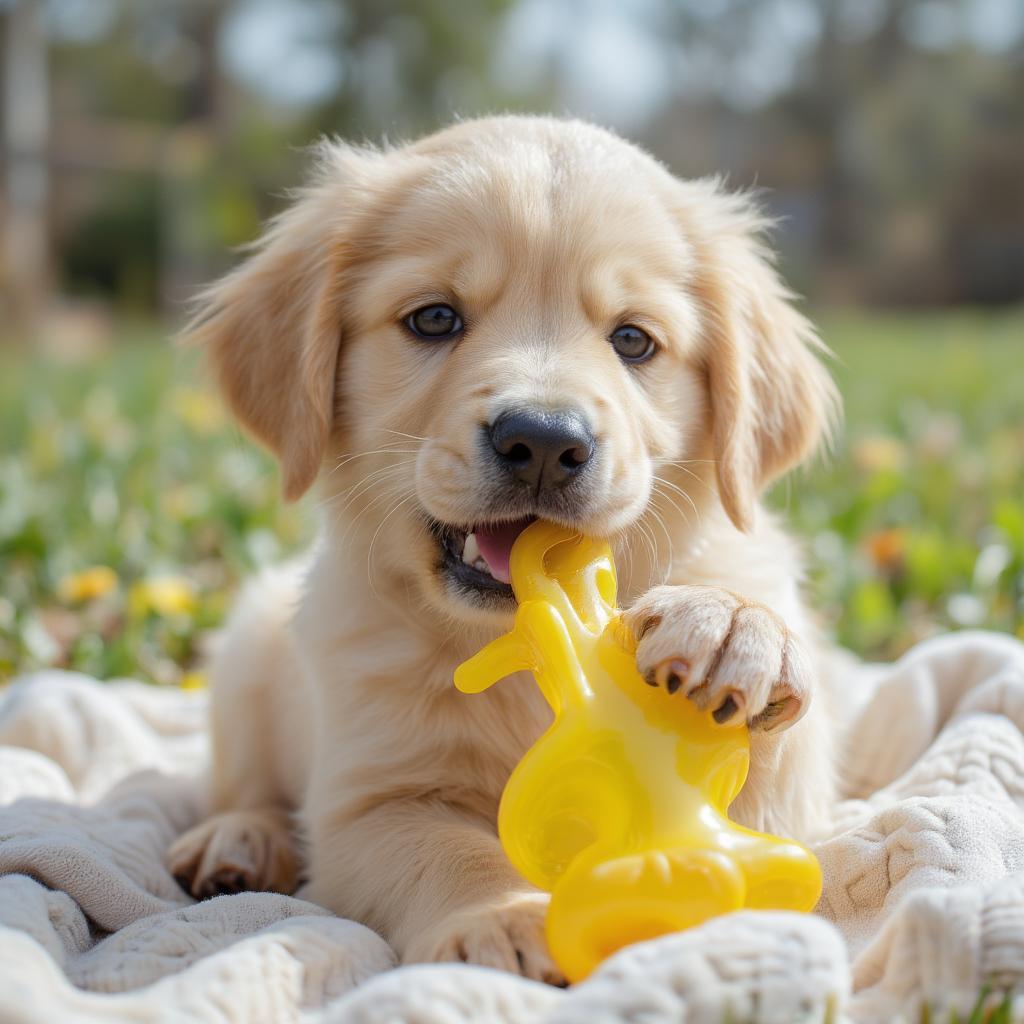Choosing the right chew toys for your 9-week-old puppy is crucial for their development and well-being. At this young age, puppies are teething and exploring the world with their mouths. Providing them with safe and appropriate chew toys helps alleviate teething discomfort, prevents destructive chewing behavior, and promotes healthy dental development.
Why Chew Toys are Essential for Your 9-Week-Old Puppy
A 9-week-old puppy is a bundle of energy and curiosity, constantly exploring their surroundings. Chewing is a natural instinct for puppies, driven by teething pain, boredom, and the need to explore textures. Providing appropriate chew toys for a 9 week old puppy is vital for several reasons:
- Teething Relief: Puppy teeth are sharp and their gums are sore. Chewing on safe toys helps soothe their discomfort and provides a healthy outlet for their chewing urges.
- Preventing Destructive Chewing: Without appropriate chew toys, your puppy might turn to your furniture, shoes, or other household items to satisfy their need to chew. Providing them with a variety of appealing toys can redirect this behavior.
- Dental Health: Chewing helps strengthen jaw muscles and promotes healthy tooth development. Certain chew toys can even help scrape away plaque and tartar buildup, contributing to good oral hygiene.
- Mental Stimulation: Chew toys can provide mental stimulation and prevent boredom, especially when you’re not available to play with your puppy. Puzzle toys that dispense treats can keep them entertained for hours.
Choosing the Right Chew Toys for Your 9 Week Old Puppy: Safety First!
When selecting chew toys for 9 week old puppies, safety is paramount. Consider the following factors:
- Size and Durability: The toy should be appropriately sized for your puppy to prevent choking hazards. It should also be durable enough to withstand their sharp teeth and enthusiastic chewing. Avoid toys that can be easily torn apart and swallowed.
- Material: Opt for non-toxic materials that are safe for your puppy to ingest. Look for toys made from natural rubber, nylon, or durable cotton. Avoid toys with small parts, sharp edges, or easily detachable pieces.
- Texture and Variety: Offer a variety of textures to keep your puppy interested. Soft plush toys, textured rubber toys, and rope toys can all provide different chewing experiences.
 Puppy Chewing on a Safe Toy
Puppy Chewing on a Safe Toy
Types of Chew Toys for a 9-Week-Old Puppy
There’s a wide variety of chew toys for a 9 week old puppy available on the market. Here are a few popular options:
- Rubber Chew Toys: Durable and often come in various shapes and textures, some even have treat dispensing options.
- Rope Toys: Great for tug-of-war and chewing, providing dental benefits by helping to clean teeth.
- Plush Toys: While not as durable as rubber or rope toys, they can provide comfort and companionship for your puppy. Choose plush toys specifically designed for puppies and supervise their use.
- Teething Toys: Designed to soothe sore gums, these toys are often made from soft rubber or have textured surfaces. They can be chilled in the refrigerator for added relief.
What to Avoid When Choosing Chew Toys
- Cooked Bones: These can splinter and cause serious internal injuries.
- Rawhide: While popular, rawhide can be difficult to digest and pose a choking hazard.
- Toys with Small Parts: These can be easily swallowed and cause choking or intestinal blockages.
- Toys Treated with Harsh Chemicals: Choose toys made with non-toxic materials to ensure your puppy’s safety.
Introducing Chew Toys to Your 9-Week-Old Puppy
Introduce new toys gradually and supervise your puppy’s playtime. Encourage them to engage with the toys by playing tug-of-war or fetch. Rotate toys regularly to prevent boredom and keep your puppy engaged.
“Introducing a variety of safe and engaging chew toys is crucial for a puppy’s development,” says Dr. Emily Carter, a veterinarian specializing in canine behavior. “It helps them learn appropriate chewing habits and prevents destructive behaviors in the long run.”
Conclusion
Choosing the right chew toys for a 9 week old puppy is a critical part of responsible pet ownership. By providing your puppy with safe, durable, and engaging chew toys, you can help them navigate the teething phase, develop healthy chewing habits, and enjoy a happy and healthy puppyhood.
“Remember to always supervise your puppy with any new toy and discard any damaged toys to prevent accidental ingestion,” adds Dr. Carter. “A well-chosen chew toy can be a puppy’s best friend!”
FAQ
1. How often should I replace my puppy’s chew toys?
Replace any damaged or worn-out toys immediately to prevent choking hazards. Regularly inspect toys for signs of wear and tear.
2. What if my puppy swallows a piece of a chew toy?
Contact your veterinarian immediately if you suspect your puppy has swallowed a piece of a toy.
3. Can I give my puppy ice cubes to chew on for teething?
While ice cubes can provide temporary relief, they can also damage your puppy’s teeth. Opt for specifically designed teething toys that can be chilled.
4. Are all rope toys safe for puppies?
Choose rope toys specifically designed for puppies. Avoid ropes that can easily unravel and be ingested.
5. How can I tell if my puppy is teething?
Signs of teething include excessive chewing, drooling, whining, and swollen gums. You may also find small puppy teeth around the house.
6. What if my puppy doesn’t seem interested in chew toys?
Try different types of toys and textures. You can also try stuffing a hollow toy with treats or peanut butter to make it more enticing.
7. When does teething usually end for puppies?
Teething typically ends around 6-7 months of age, when all their permanent teeth have erupted.
